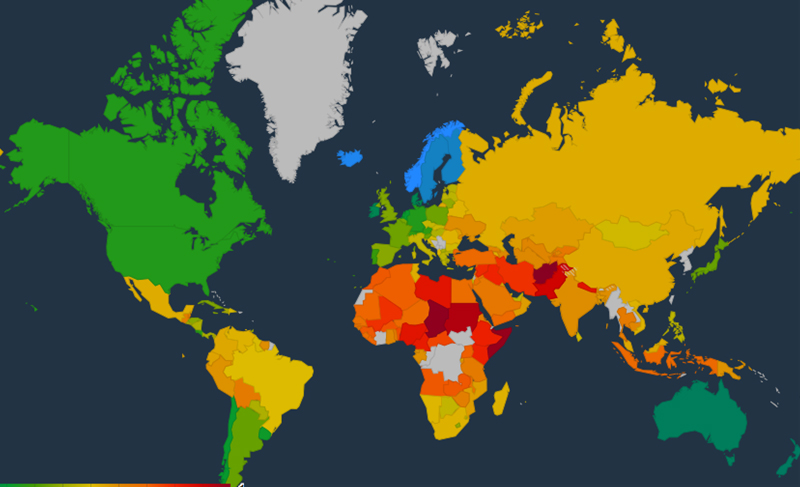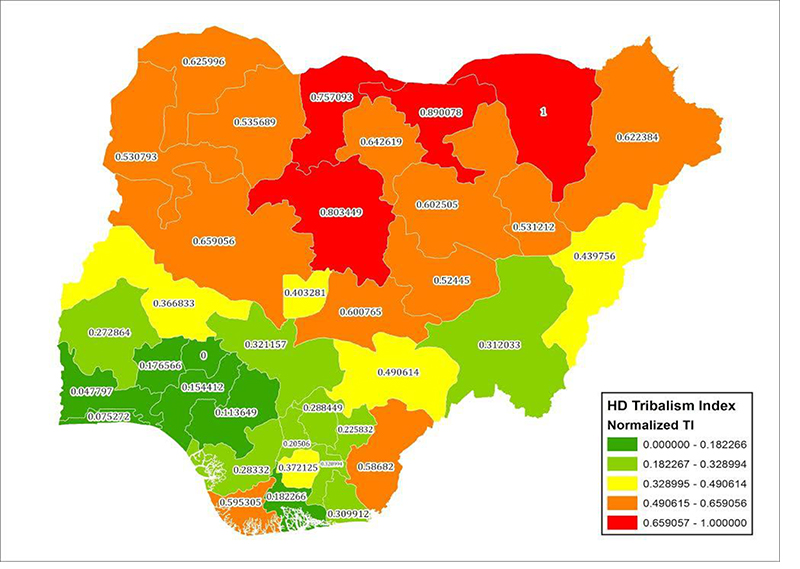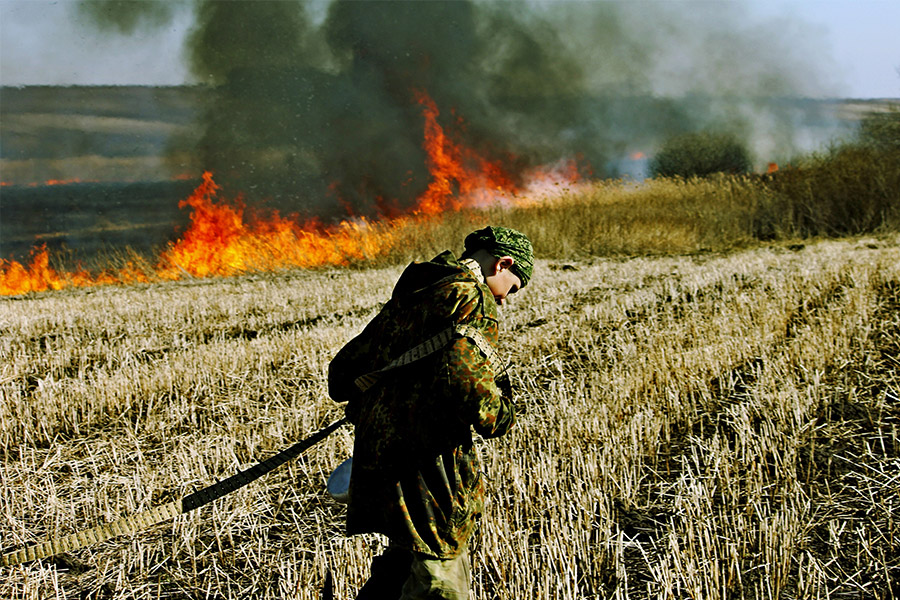The first decades of the 21st Century have marked a notable new trend in global violence, namely the growth in incidents of civil conflict. These types of conflicts are distinguished as occurring between states and non-state groups (like Al Qaeda), and between non-state groups themselves (such as in the civil war in the Congo). In many cases such conflicts have also taken on a religious dimension. On the other hand, traditional wars between states have declined to an historic low.
How do we explain this phenomenon?
In research conducted at the University of South Florida (USF) sociology professor David Jacobson and assistant professor of international relations Zacharias Pieri addressed this question primarily through establishing the drivers of violence. In doing so, the duo built upon the first systematic measure of civil violence, called the “Tribalism Index.” This index was designed by David Jacobson and Natalie Deckard, to compare countries on a global level and to capture key components driving civil violence around the world, including factors such as fractionalization, grievances (perceived or real), corruption, and women’s’ status.
Though the term “tribe” generates mixed feelings--people in the Middle East, for example, readily use the word while West Africans object to the term--it denotes a social form which has been historically the dominant kind of human association. Generally, this social form is marked by high decentralized organization into many families, clans and tribes. Women frequently have second-class status, often severely so. Fractional grievances can lead to long term feuds.
The Tribalism Index seeks to measure these phenomena, from women’s status to grievance in a more quantifiable way. From there, we can measure certain outcomes, from the effect on voting to levels of violence.
Each country is “scored” from the low end of tribalism or tribal patriarchy to high, from 0 to 1. (See Map 1).

Map 1
All countries will accrue some measure of a tribal patriarchy score—whether deriving from even minimal gender inequalities, ethnic fractionalization, or perceptions of corruption. Even if a society has no tribes as such, elements of tribalism will be apparent to varying degrees. We capture certain social qualities here, not just tribes in the narrow sense—but the extent of such qualities varies.
The Tribalism Index is able to statistically predict 68 percent of rates of religiously motivated violence (based on data drawn from tabulations of the National Counterterrorism Center [NCTC] for 2005 to 2010.)
“If we control for the presence of tribalism, a larger Muslim population actually has a modestly negative relationship with violent religious terrorism. Simply put, as tribalism increases, so does violence; but as the population becomes proportionally more Muslim, religiously motivated violence modestly decreases,” stated Jacobson.
What does this mean?
In essence, we are able to isolate tribal patriarchy as a major factor in driving religiously motivated violence when we seek to predict the patterns shown in NCTC data—rather than religiosity.
A state’s movement from one end of the tribal patriarchy spectrum to the other predicts an extraordinary increase in the production of religious violence on the part of its nationals. Although increasing tribal patriarchy is associated with increasing violence, tribal patriarchy has a negative relationship with the export of violence across borders. This makes sense, since tribal violence tends to be more geographically insular. But the percentage of Muslim population had a positive relationship with the exportof violence. Simply put, Muslim societies are somewhat less violent than their non-Muslim counterparts if we factor out the presence of tribalism.
Professors Jacobson and Pieri, together with their colleagues on the project, also applied the Tribalism Index in the context of research on Boko Haram. Boko Haram is a militant Islamist group best known in the West for its abduction of hundreds of school girls, and for its campaign of violence in the north of Nigeria and the wider Lake Chad region, with a goal of implanting an Islamic state. Such groups are most likely develop in tribal patriarchal environments where the social environment can facilitate and nurture them. In his recent book, Boko Haram and the Drivers of Islamist Violence, Pieri argues that all these factors were present in Northern Nigeria driving the emergence and evolution of Boko Haram.
The north of Nigeria has long had some of the worst levels of education in the world, and especially when compared to the south of Nigeria. The situation for girls is especially bleak. Reports from the United Nations highlight that fewer than 50 percent of girls in the north attend school. At the same time, over 60 percent of girls in the north are married before the age of 18, and expected to give birth to a child within the first year of marriage. See Map 2.

Map 2
Mohammad Yusuf, Boko Haram’s initial leader presented Nigeria as corrupt and ineffective state, blaming the central government and its failure to implement a just system of governance as especially problematic. In their analysis of Boko Haram’s speeches, the USF researchers found high indices of grievance centered around the issue of corruption in Nigeria.
In essence, Nigeria is one of the most corrupt states in the world, and Boko Haram was able to use this grievance to challenge the existing order, as well as to provide a utopian ideal of what Nigeria could look like under a strict Islamic order. Yusuf was powerful in highlighting the fractionalized nature of the Nigerian state; he argued that the Christian South of the country was attempting to dominate the Muslim North, and to hold back its development as a means of keeping Muslims out of power.
Yusuf was eventually killed extrajudicially in 2009 by Nigerian military. Abubakar Shekau, Boko Haram’s new leader argued that violent jihad was the only way forward. Boko Haram targeted alienated young men in the North for recruitment, pushing a version of hyper-masculinity, and promising them weapons and women – in a sense allowing them to conform to a patriarchal version of masculinity prevalent in Northern Nigeria. Boko Haram also prospered in part due to Nigeria’s fractionalized nature, finding a stronghold in the predominantly Kanuri Northeast, while at the same time stressing a puritanical version of Islam as a binding force that can transcend tribes.
It is evident then that the factors stressed by the Tribalism Index were significant in Boko Haram’s spree of violence over the past decade, which has left tens of thousands dead and millions displaced.
Boko Haram is a particularly violent illustration of why civil conflict has expanded more broadly, in a way that goes well beyond Islamist groups. Clan societies around the world tend to be conservative on issues such as women’s rights. This is not universally true. The Tuareg in Mali and neighboring countries, for example, are relatively liberal on women’s status. And rarely are women denigrated to the extent of groups like Boko Haram. But it is generally the case that women’s rights trail in clan societies. (The Middle East, for example, is further behind than any other region in the world for women’s education, participation in the labor market or in political empowerment.)
As a result, as the world becomes a smaller place through globalization, through global media, the active promotion of human and women’s rights, and a global market with its attendant images around, for example women’s fashion, more conservative groups feel buffeted. Indeed, the globalization of the economy has resulted in tens of millions of women being drawn in the workforce and, as a result, having a greater degree of autonomy. Women’s education, in this context, has also made dramatic strides—in many cases passing men, in the aggregate. This is true, of course, within the West as well. Professor Jacobson demonstrated in his book Of Virgins and Martyrs: Women and Sexuality in Global Conflict, the more traditional a particular region on women’s status the more vociferous the backlash. Women’s status is a major driver for violent groups like ISIS and others. For other groups, globalization is experienced as neo-colonialism.
Unwinding these dynamics will be critical in arriving at politics which can assist in, inter alia, advancing women’s rights while ameliorating conflict.
